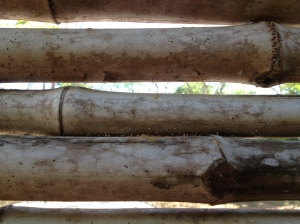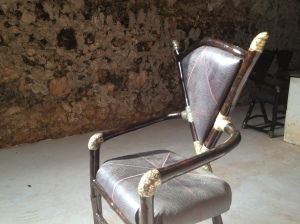Aside from the initial design of a bike’s geometry, wrapping is critical to the way a bamboo frame handles. Wraps can add stiffness and provide additional sensitivity to the feel of a bike.
Before we start, let’s take a look at some FEA models (fig 1, fig 2) to get a feel of what kind of stresses a bike is subjected to. Try and visualize the stress your frame incurs in each of the following scenarios:
1) braking heavily at top speed to prevent a frontal collision
2) riding out of the saddle at a stoplight
3) jumping off a curb
4) turning aggressively at an intersection (leaning and shifting your body weight into a turn.)
The frame tutorial below is designed for the most common stresses an urban commuter would likely be subjected to, assuming aggravated road conditions and some mid-size loads from time to time. Please adjust & reinforce accordingly for other riding styles of riding.
Pre-Wrapping
Before you actually start wrapping, make sure you go through the composite prep guide (coming soon.)
Rule of thumb for wrapping: whatever you do with one side, repeat on the other. This will help distribute the fibers evenly across the left and right side of the frames. Try and do one lug area at a time and compact the fibers immediately with electrical tape. Use long spirals when compacting with the electrical tape (similar to wrapping paths); this will prevent uneven cinching and excess movement of the fibers below. If the wraps look intimidating, test out your wrap lines with a some duct tape.
Ok, onto the step by step wrapping..
Wrapping Tutorial
Head Tube
Anchor the first piece of fiber on the TT (or DT) and spiral diagonally down to the DT. Anchor the second piece of fiber on the TT and spiral diagonally down to the DT in the opposite direction. Viewed from the front of the bike, the fibers should mark an X across the headtube. With a slight offset, continue wrapping the additional fibers along the same paths as the first two pieces of fibers. The resulting weave of fibers should create an overlaying X shaped matrix spiraling from the TT to the DT.
Seat Tube
1st Wrap Set (provides lateral stiffness between front and rear triangle)
Anchor your first piece of fiber on the TT and spiral counter clockwise to your right SS (viewed from the front) and anchor to the SS. Anchor at LL. Anchor your second piece of fiber on the TT and spiral clockwise to your right SS. Anchor at LL.
Repeat on the left side.
2nd Wrap Set (latches front and rear triangles together and adds some lateral stiffness)
Anchor your first piece of fiber on the TT and spiral counter clockwise (viewed from the front) toward the rear of the frame, loop once around the bottom ST and continue to spiral toward the right side SS. Anchor at LL.
Anchor your second piece of fiber on the TT and spiral clockwise toward the rear of the frame, loop once around the top ST and continue to spiral toward the right side SS. Anchor at LL.
Repeat on left side.
3rd Wrap Set (latches front and rear triangles together and adds torsional & lateral stiffness)
Anchor your first piece of fiber on the TT and spiral counter clockwise (viewed from the front) towards your right SS. At the junction of your right SS & SS wrap below and spiral your anchor onto your left SS.
Anchor your first piece of fiber on the TT and spiral clockwise (viewed from the front) towards your right SS. At the junction of your right SS & SS wrap above and spiral your anchor onto your left SS.
Finishing Wrap Set(s)
Start with an anchor along a LL and repeat one of the wraps above with attention to any air & fiber gaps. Repeat on the opposite side. If necessary, use compacted spirals to bulk up and compact the fibers. Keep in mind that any fiber you create in the wrap at this stage can be sanded down later so be liberal and don’t be afraid to over layer & bulk up – these are your sacrificial layer of fibers. What you don’t want to do is leave an excess of gaps during this last layup and be forced to sand down to your structural layups later.
Bottom Bracket
1st Wrap Set (provides torsional and lateral stiffness between)
Anchor your first piece of fiber on the DT and start to the spiral clockwise from the top of your DT lug line. Pull the fiber toward the bottom of bottom bracket. Keep left and spiral to the LL of your left chainstay. Anchor there.
Repeat on the left side with a counter clockwise spiral anchor on your right chainstay.
Repeat both sides with an offset wrap following the same wrap paths.
2nd Wrap Set (provides torsional and lateral stiffness between)
Anchor your first piece of fiber on the DT and start to the spiral clockwise from the bottom of your DT lugline. Pull the fiber toward the bottom of bottom bracket. Keep left and spiral to the LL of your left chainstay. Anchor there.
Repeat on the left side with a counter clockwise spiral anchor on your right chainstay.
Repeat both sides with an offset wrap following the same wrap paths. Be sure to cut through the middle (red line) of the chainstays as you create a matrix of spirals around both chainstays.
3rd Wrap Set (provides lateral stiffness between front and rear triangle)
Anchor your first piece of fiber on the DT and spiral clockwise to your right CS (viewed from the front) and anchor to the CS. Anchor your second piece of fiber on the DT and spiral counter clockwise to your right chainstay. Repeat on the left side.
4th Wrap Set (adds stability to BB)
Anchor your first piece of fiber on the ST and spiral clockwise toward the ride side of the BB. loop around BB once and spiral back to ST. Anchor your second piece of fiber on the ST and spiral clockwise toward the ride side of the BB. loop around BB once and spiral back to ST. This should produce a figure 8 / double helix looking loop from the BB to the ST on both sides of the bottom bracket.
5th Wrap Set (continue adding lateral stiffness and fill gaps)
Starting from the right, repeat the first set of wraps with slightly more compacted spirals. Covering any gaps in the wrapping as need. Repeat on the left side.
Finishing Wrap Set(s)
Start with an anchor along a LL and repeat one of the wraps above with attention to any air & fiber gaps. Repeat on the opposite side. If necessary, use compacted spirals to bulk up and compact the fibers. Keep in mind that any fiber you create in the wrap at this stage can be sanded down later so be liberal and don’t be afraid to over bulk – this is your sacrificial layer of fibers. What you don’t want to do is sand down to your structural fibers later from an excess of gaps you leave here.
Dropouts
These are pretty straight forward. I start the anchor on the metal dropouts end and pull diagonally across the lug space. Once you’ve anchored on the other end, repeat the spiral back and forth. Try to create wide spirals, which will keep the bulk of the lug to a minimum and provide more horizontal stiffness. Remember excessive bulking at the anchor points can be sanded down later.
Wrapping Terms & Tips
Abbreviations
BB – Bottom Bracket
CS – Chainstay
DT – Downtube
HT – Headtube
LL – Lug Line, the farthest point where you will be wrapping along a bike tube.
SS – Seatstay
SPS – Seatpost Shim, the metal sleeve that fits your seatpost
ST – Seat Tube
TT – Top Tube
Anchoring – Generally one and a half to two loops around the tube to create a point of pull for the fibers. A good anchor will allow fibers to be woven tightly across the joints.
Spiraling – Wrapping in a spiral path along a load path or tube. Try and use elongated spirals for most of the wraps and avoid compacting them. The longer spirals will provide greater lateral stiffness whereas the compact spiral wraps will add greater horizontal stiffness.








